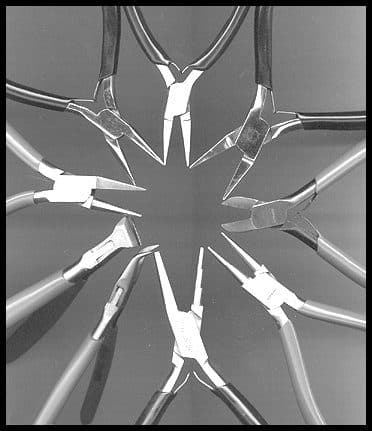
Wire Jewelry Pliers: What to Look For
Jewelry pliers are the primary tools of wire artists. Learn about the different types of pliers and their uses as well as what to look for in these tools.
4 Minute Read
Toolaholics
Wire artists' love of hand tools is not the only thing they have in common. Many are confirmed toolaholics and proud of it. Legends have been shared about particular artists and the incredible number of tools they own. These stories often precede them. This poses many questions, such as: "Why," "What early life trauma led them to this," and "Have they ever considered seeking help?"
When watching wire artists choose their jewelry pliers, you'll notice their nimble fingers expertly sliding up the handle and over the jaws while the vinyl cushion grips slip into their waiting palm. These artists are adept with their hands. However, some careful observers have reported seeing a quick, frisky pinch of the vinyl. You might hear a soft exhalation and a just-audible moan as their eyelids flutter for an instant. Or you may see them replace the pliers with a "hmph" and an air of dismissal.
What to Look For in Round-Nose Jewelry Pliers
What are they looking for? As a general rule, not much. But that "not much" is sure hard to find.
For example, when evaluating round-nose pliers, the wire artist is looking for a truly ROUND jaw. Not an oval. Not one that has ridges or flat spots. Why? Because wire artists know all of their loops, coils, and circles will reflect on their surfaces whatever they have felt from the jaw. This jaw must be smooth so it won't scratch the surface of the metal. The artist will also judge the space between the jaws to determine if the pliers will hold the wire securely. If the space is too wide, the wire will slip.
Box-Joint Construction
It's very likely that the first pair of pliers every wire artist purchases are inexpensive ones that don't last because of their construction. Box-joint construction outlasts and outperforms all other types. It keeps its precise alignment, never loosening or wobbling, and opens and closes smoothly.
The Grip
Knowing they will hold jewelry pliers for long hours, artists will test how it feels in their hand. The tool must feel comfortable. Manufacturers understand this need, so they offer plastic and foam-grip handles. This not only provides grip but also gives some insulating qualities.
Flat-Nose Jewelry Pliers
The same criteria apply when evaluating flat-nose pliers. However, because wire artists use these pliers for different purposes, we add a few more attributes to the "wish list."
Flat-nose pliers come in different sizes. Their size will determine their application. For example, you can use wide-nose pliers to bend the end of the wire over when you begin your bindings. However, they wouldn't work well in tight spots, such as those in many ring designs.
Tapered and slim, flat-nose pliers would work well in those tight spots. Since the inside surface of flat-nose pliers may be either smooth or serrated, the wire artist must make sure that the surface is smooth.
Cutters and Nippers
Wire artists can purchase cutters and nippers as side cutters or end cutters. The shape of the edges of the jaw will determine how they cut the ends of wire, either a flush or semi-flush cut. In a flush cut, the edge of the wire is cut off squarely. A semi-flush cut leaves a point on the end of the wire. Depending on the need and the desired result, both types of jewelry pliers and cuts are useful.
Combination Pliers
Round-nose pliers, flat-nose pliers, and cutters/nippers are the three basic tools required to start a career as a wire artist jeweler. There are also combinations of these pliers, such as pliers that have one round-nose jaw with an opposing flat-nose jaw, rosary pliers (round-nose pliers with a side cutter), and so on.
Specialty Pliers
There are also specialty pliers, such as coiling pliers or bent chain-nose. When an artist needs the tapered jaw of a round-nose but the flat surface of a flat-nose, they may use chain-nose pliers. They have bevelled jaw edges to prevent the marring of soft wire.
Choosing these specialty jewelry pliers comes down to a matter of personal preference and technique. Just check out various tool catalogues for technicians and craftsmen to see all the variations and choices available.
Additional Tools
To complement these hand tools, wire artists frequently use:
- Pin vises
- Ring mandrels
- Bench (or jewelry) vises
- Calipers
- Rulers
- Pocket or pen knives
- Jeweler's files
- Ring sizers
- Optivisor
Jewelry Pliers are Just an Extension of the Artist's Hand
In defense of the many plier enthusiasts you may meet, wire art is really a study of how to successfully manipulate wire into a certain shape. Jewelry pliers and other tools used to do this are just an extension of the artist's hand. They should be used to guide the wire into place without undue pressure or force. Since the tool is so critical, it comes under scrutiny.
As an artist becomes more involved with the art form and begins to play with design, inevitably, specific tools begin to find an exact use. Hence, the 101 jewelry pliers.
The IGS has published this article compliments of the Wire Artist Jeweler. For recommendations for purchasing jewelry pliers, see our review article.
Related Articles
Odd Round n’ Round: Faceting Design Diagram
What Is a Third Hand Used for in Jewelry Making?
Jewelry Torches: A Beginner’s Guide
Cool: Faceting Design Diagram
Latest Articles
800 Years of Mogok: A Celebration in Tenuous Times
What is the Average Gemstone Faceting Yield?
Pyroxmangite Value, Price, and Jewelry Information
How to Identify Emerald Simulants and Synthetics
Never Stop Learning
When you join the IGS community, you get trusted diamond & gemstone information when you need it.
